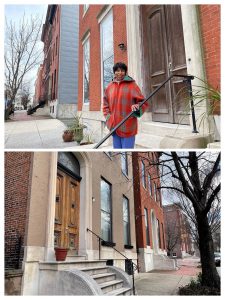
Look up and down the stretch of Eutaw Place that forms Bolton Hill’s southeastern boundary today and you’ll still see gorgeous old brick and brownstone mansions – mostly well-kept and owner-occupied. Many of the city’s most prominent and wealthy professional and mercantile families once resided in the houses along the 1300 to 1800 blocks, from not long after the Civil War until the early 20th Century, when they moved out to Roland Park and beyond.
But by 1972, many of those historic places had been cut up into what the city’s housing director at the time, Robert C. Embry, called “real rabbit warrens.” The Baltimore Sun called Eutaw “a hotbed of petty crime and thievery,” with poor families crammed into small apartments owned by slumlords, in an article headlined City moves to save Eutaw Place.
While there was discussion of demolishing the buildings, Embry kicked off an experimental program to get rid of neglectful landlords and find new owners to rehabilitate, occupy and maintain 11 of the homes and two vacant lots. He was nudged to do so, according to the Sun, by a lawyer and former city council member named Thomas Ward, who lived in Bolton Hill, owned two houses on Eutaw and saw “the possibilities of these magnificent old properties.”
Those 11 buildings had been parceled into 92 apartments along what was said to be the first great urban boulevard with a park (we call them medians) at its center in America. Originally known as Gibson Street, in 1853 the name changed, and Henry Tiffany oversaw the creation of a continuous parkway with fountains, sculptures and gardens. Big residences were going up all around. But a century after its naming, Eutaw was rapidly declining. Two local investors, Maurice Glick and Samuel London, were singled out by the Sun for their predatory practices as landlords in the area, charging low-income tenants excessive rents by the week. A fire in 1962 in the 1300 block of Eutaw claimed the lives of five children.
The city bought or otherwise obtained the properties in 1972 and that’s when Henri Daniels and Cristine Barnes came into the picture. They each qualified under the city’s terms and bought two of the bigger houses, at 1308 and 1405 Eutaw Place. Half a century later, they’re still there, proud owners of those well-preserved properties.
They each paid the city just $1,600 for possession and were provided a construction loan at 3 percent and a city-selected contractor to help bring the properties back to life. Owners had to live in the properties for five years or more. Henri Daniels was living in Sutton Place Apartments and often walked in the neighborhood along Eutaw Place. “I still refer to the median as the ‘park’.” It is one of the most attractive features of Eutaw Place….” She had been born on a farm in North Carolina, moving to Baltimore at age 10 after her parents died, living with an older sister and her husband on North Avenue. By the time the Eutaw Place houses became available, she was working as a city social worker.
The red brick house she acquired was built in the 1870s and had been chopped into seven vacant apartments. “It needed everything – a roof, floors, plumbing, HVAC.” An empty lot next door offered parking. She moved in while the restoration continued, married and gave birth to a daughter who now is a doctor in Baltimore County. Henri occupies one of the house’s four apartments, which, she says, “is about ready for renovation again.”
Christine Barnes met her late husband, Ken, in graduate school in Pittsburgh and with another couple, Marvin and Sara Bingham, moved here. They took jobs, the four of them, in Baltimore County schools. Christine left work to have the first of two children. She recalls that there was a competition to qualify for the houses and that a city employee, who lived in Bolton Hill, tried to discourage them from buying the houses in hopes of getting them for a developer in a shady deal. “We got an appointment and went to see Embry and told him about it.” She and her husband got a house in the 1400 block of Eutaw, near West Lafayette Ave. They “camped out in the basement” during renovation. A spread in the Baltimore News-American on April 28, 1974, on the Eutaw Place project featured a photo of Christine on a ladder spreading solvent and removing old paint from original woodwork.
That house had been originally built around 1865 but in the 1950s or 60’s was “divided into 11 apartments with tiny rooms and kitchens,” she recalled. “It had original wooden trim and plaster moldings, covered by layers and layers of paint and wallpaper.” The city-assigned contractor did the basics, she said, but it was left to her, mostly, to scrape the paint and restore the long-covered finer touches of the house, which are glorious today.
“We were close to one other couple and came to know the others who bought the houses. We became friends.” Some of them sold and left after five years. Her family lived in a large part of the house and rented our three apartments. Her granddaughter lives in one unit now and is helping assemble a history of the house. Ken Barnes died on June 14, 2023.
—Bill Hamilton
